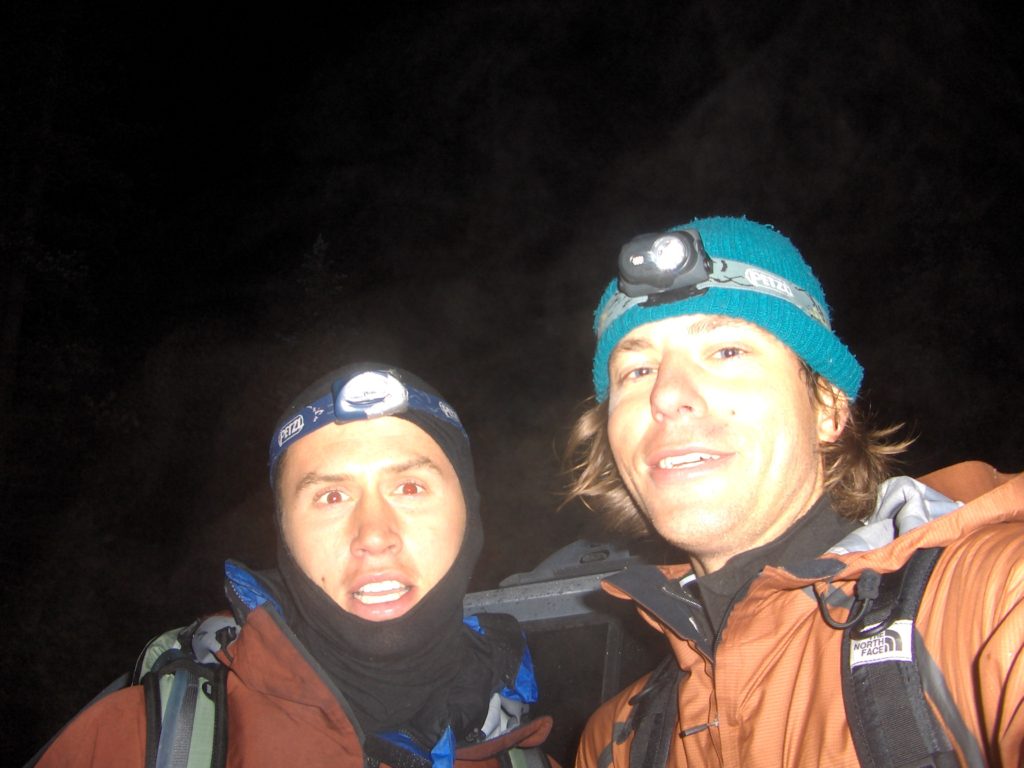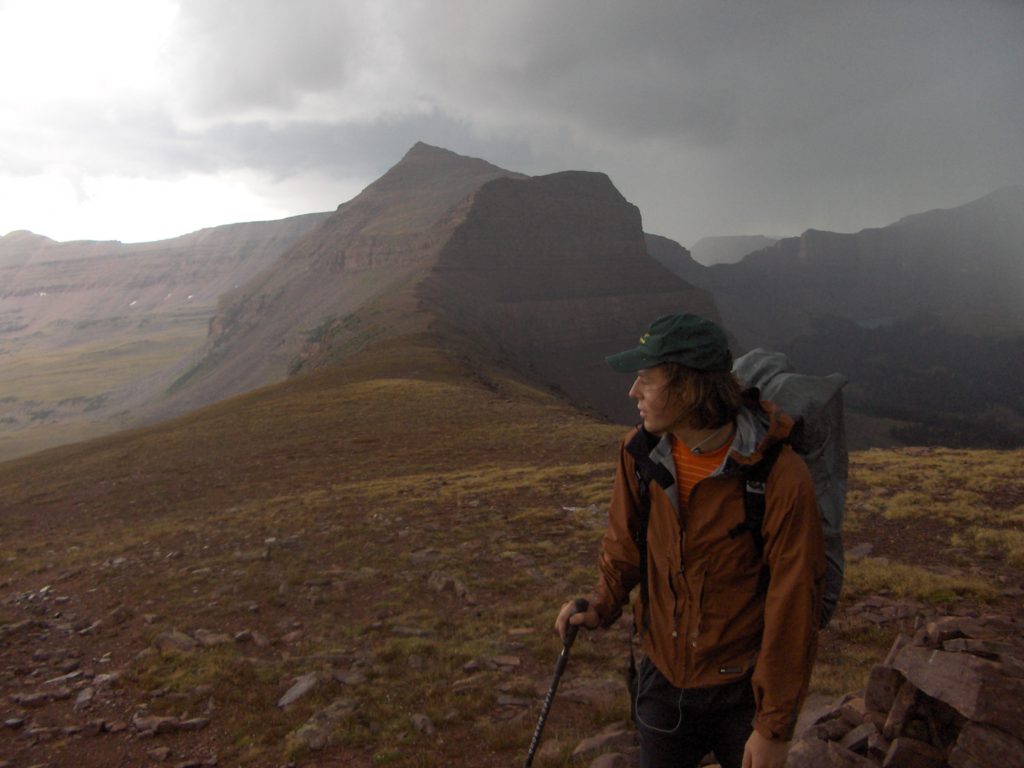
2019 note: the following account was from a 2006 attempted ‘fastpack’ of the High Uintas Highline Trail. This was before I really knew about fastpacking and/or ultra running. It was definitely high adventure for me and a cherished memory. I dredged up this account and thought it worthy of a repost.
I don’t know how or when this trip was concocted. Perhaps it was just an outgrowth of younger aspirations from years past. Clearly it was devised at a low elevation in the warmth of summer, far from cold thin air. However it happened I’ve forgotten, but Hunter and I found ourselves at the west end of the High Uintas Highline trail, concoction complete, ready for a lightweight speed crossing of the range. Our brutal car shuttle to the other end of the trail took nearly 10 hours from SLC due to terrible roads and some minor car trouble; complicated by the lack of restaurants open at 11pm on a Thursday night in Roosevelt. We spent the short night camping near Mirror Lake at the Highline trailhead avoiding the persistent drizzle of rain.
Looking at our packs I would have guessed we were heading up nearby Hayden’s Peak for a quick afternoon hike. My pack weighed maybe 12 pounds and Hunter’s was a little more- maybe 15 pounds. We were each carrying a comically serious minimum. Both of us had good lightweight rain gear, belay jackets, first aid kits, basic food, and well, emergency blankets. The idea was that we would truly lighten up by leaving the sleeping bags and only sleep in basic shelters inside our emergency blankets wearing our belay jackets. It would be a classic bivy- substituting a bivy sack for an emergency blanket. It was late August and summers in the Uintas are fairly mild and besides, we could survive anything for one night… right? Well, maybe.
We finally hit the trail. The first miles nearing Rocky Sea Pass went quickly. Scudder Lake, the junction for Naturalist Basin, Pigeon Milk Spring, all passed with the obligatory high spirits. Hunter’s new trail running shoes were already giving him some grief and he stopped periodically to patch new flesh holes. Reaching Rocky Sea Pass first, the daunting began with a start. We were already an hour behind schedule having purposefully overslept; blasted car shuttle. Gazing east I slowly picked out the distant landmarks. Ostler Peak, Explorer Peak, and finally, seeming twenty miles away, Dead Horse Pass, partly hidden by an unnamed sub-peak. The distance was baffling. I had stood here on another Highline crossing ten years previous and felt a similar fate; that time I had five days on my hands.
Hunter arrived at the Pass shortly. We snapped a few pictures and silently acknowledged the distance. We moved on quickly, knowing time was only against us. The perceived distance made Rock Creek Basin seem like an eon to pass. We ran the first two or three downhill miles, packs jostling along, until we hit the main stream. This began the measured climb out. Multiple miles found us back in clearings, near the tree line, lagging. Here we stopped our first rest of the day, about a mile from Ledge Lake. I tried to eat, but was barely able to finish a cliff bar- Carrot Cake, my favorite. The daunting I felt at Rocky Sea had migrated into anxiety and insecurity. We were going a lot slower than I had hoped and I was feeling a lot more tired than I had expected. I figured the hurting would start at Red Knob Pass (pass number three) but we were already feeling it one pass early. Choking down the end of my bar I glanced over at Hunter patching his feet again. I knew he must be in pain but as usual, he offered no complaint.
The next several miles over Dead Horse Pass passed in a haze. I remember coming across an odd note at a trail junction from a solo hiker worried he might be lost. No sight of him so maybe he survived. We watched the weather closely as we reached the pass. The previous gray clouds were building dark with intensity and the wind was howling like a freeway. Weather aside it felt damn good to be knocking off another pass. I stood and hollered down at the blue-green Dead Horse Lake, hoping EJOD, the blessed lake to the west, would acknowledge. We paid our homage to the goat throne built and destroyed nearly a decade before on a past visit to the waters of EJOD. Finding the hidden trail off Dead Horse Pass I was able to run the downhill to the lake, but Hunter with his feet in pain wasn’t as quick and hiked most of the way off. Reaching the lake, we came across the only hikers we saw in our entire crossing. A father and his two adult boys were camped out for the week, but had forgotten their tent and had constructed a basic shelter with a poncho. We chatted and shared our goal of crossing; they were disbelieving and almost laughed when we told them where we were headed and the distance we still needed to travel. It was already after 3 P.M. and and we had hoped for two more passes and loads of miles.

Two miles further and were moving up the Scottish-like green slopes of Red Knob Pass. Somehow horse meat was the topic conversation keeping our minds off the task ahead. We were moving slower now and clouds were growing sinister and the rain was wetting my brim. It was too steep to run, and we instead paced ourselves moderately uphill. As we neared the base of the Pass we looked west to see Beulah, and the entire Allsop Lake area engulfed in the blackness of a Uinta fall storm. It was moving our way, and we needed to turn the power on. The western peaks were already white with snow and we knew our time was short. Reached the first of the two Red Knob passes the thunder was already deafening and the lightning sickly close. Flash… one, two, Boom. It was too near. We hit the true pass and strangely found time to take several pictures before the deluge of hail and snow hit us from behind. Hastily we were running again, this time to preserve our lives. Initially we stuck to the mellow switchbacks descending into Lake Fork, but as the hail increased and the lightning struck nearby we took to barreling straight down the hill. The nearest trees were nearly a mile off and in our minds, our only salvation from the lightning. We should have taken the advice of the sheep we passed as we ran and stayed put- doing a lightning drill. But somehow that mile passed almost momentarily fueled by adrenaline and thoughts of self preservation. We squatted in the stunted trees and waited. Fifteen minutes and the lighting had passed, but the hail was still pounding, mixed with snow. We moved on sighting sheep herder smoke in the distance. Maybe they would let us stop in for a visit and dry out- an over-protective blue heeler gave us our answer.
The trail into Lake Fork was long since lost and we were soaked. The clouds and incessant hail brought a darkness that made it seem like a early winter evening. We trudged downhill, feet soaked, avoiding the bogged meadows and the overgrown pines. Finally, we unearthed the map out and figured the trail was on the opposite side of the river and there we headed. The trail was a river of melted hail and snow which further waterlogged my aching feet. But it felt good to at least know where we were with three major passes and over twenty miles behind us. We reached the next junction and knew we needed to get dry. Hypothermia was gnawing at my body. Optimally we had hoped to cross Porcupine Pass the first day, leaving day two much easier. Yet, here we were, at least 8 miles from the pass with only two hours of wet dusk-light left with both of us borderline hypothermic. We decided to gut it out for another hour and then make camp. The next two miles were hell. We were both frozen; the trail was a river of ice, we were beat, and for me, the anxiety was overwhelming. My mind we filled with fears of hypothermia, snowfall, extreme distances, and the thought of having left my wife home alone.

The hour passed and we found some basic shelter in a dwarfed grove of trees at nearly 10,500 feet. We wasted no time in building a fire knowing it would be our only salvation from the moisture. My hip which was injured training for a past marathon began to seize up and I shuffled around looking for firewood. Hunter was hobbling too on his tortured feet. The hail had changed to a bitter cold rain and all the wood was soaked and gray. Only with coercion from Hunter’s small stove were we able to finally get a small fire started. What a difference. Spirits were lifted from trauma to moderation. We set about building our shelters. Mine the footprint from my SD tent tarped over me in an A-Frame; Hunter’s, a hammock with a rigged rainfly. We had left the tent at the last minute to shave an extra pound. Fools we were.
The rain broke for a period just long enough for us to cook and eat. I couldn’t wait to get into my shelter and go to sleep and opted against the sleeping pills. Finally I was listening to the crinkling of the emergency blankets as we each crawled into our foil cocoon. The temperature was dropping and the struggle to get into dry clothes left me shivering uncontrollably. I thought the blanket would warm quickly, but an hour later I was still shivering direly. From the sound of quivering foil nearby I knew that Hunter was suffering a similar fate. Making the cold worse was the continual condensation that was building up inside the blanket. It was slowly dripping down the foil bag and soaking my jacket, my thermal tights, and anything else inside the bag. My cotton bandana did a quick mop-up job every 15 minutes in hopes of thwarting the condensation but two hours later I was still fighting the same battle: shivering, condensation, moping, hiding from the rain. I doze off for an hour. Thunder. Boom. I’m awake again and colder than ever feeling like I am trapped in a morgue body bag.
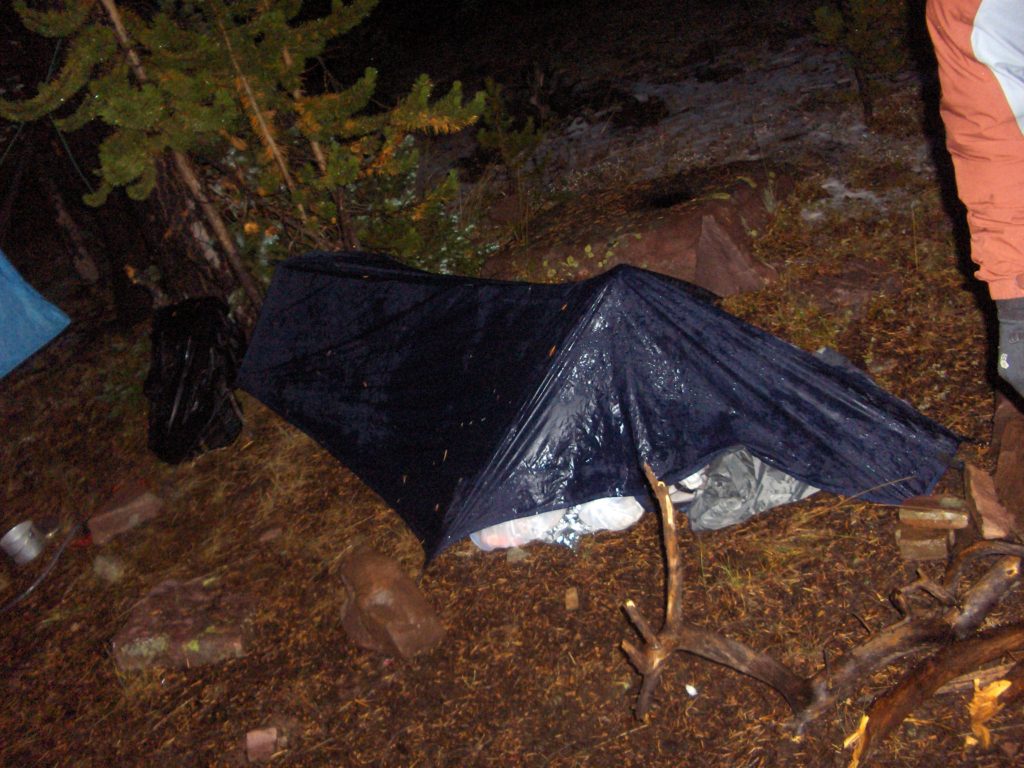
“How’s it going man?” Hunter mumbled my way. His tone hid his discomfort. I reached for the indiglo on my watch; it’s only just past midnight. I muttered a weak response and so began our hourly discourse. Neither of us could sleep; too cold, too nervous, and maybe just too scared. The night drags on; hypothermia was what I had felt three hours ago. I struggled to remember the last time I was ever this cold. Winter scout camp? No… Five A.M. the rain and hail had stopped and we were both finally too miserable to stay on our personal foil hell. I hear the crinkling of foil and Hunter is out of his hammock heading for dry firewood. We were both in dire need of warmth. The prior night’s fire was long since dead and we spent a half hour stumbling around in search of dry wood. With the final help of the portable blowtorch our respite was delivered. Dawn was finally struggling to break through the heavy clouds.
An hour of warming beside the fire breathed some limited life back into our tired minds and stiff legs. Breakfast was left over dehydrated dinner for Hunter and dried fruit for me. We broke camp slowly and finally hit the trail at 8:30 A.M. anxious to be on the far side of something; at least one more step closer to motorized travel. I figured at a minimum we had 40 miles to go today. I tried not to think about it. Our first checkpoint was the junction for Squaw Pass, our first reasonable emergency exit to the south. The GPS said it was 4 miles as the crow flies and the distance seemed to drag on. We descended off our camp’s high plateau and hear an elk bugle in the distance. A cow elk and her calf dashed north away from our trail. We head through high country and pass several old sheep herding camps and move from light timber into the high elevation plateau of upper Lake Fork. The junction for Squaw Pass was passed without a word, deciding to continue on and abandon an easy exit. The clouds were slowly rising and sun hit one of the higher peaks to the east. I prayed it would melt off the hail that blanketed the ground and save my feet from the constant cold.
The giant switchback that sweeps upward towards Porcupine Pass loomed ahead like a trail to Mordor. It was white with snow and seemed to be chiseled out of the dark mountainside as it traversed several cliff bands before one last crooked turn to the clouded Pass. The skeletal cairns, as tall as a man, haunted the valley and led the vague trail up to the switchback. I reached the switchback and looked back at Hunter and the distance behind. Lake Fork, which we just crossed spreads south as far as my eyes can see, fading into cloud covered peaks in the distance. A monstrous distance leaving me shuddering to think of the distance ahead.
In the past miles we had heard two separate rock slides, likely due to the thawing rocks. Hunter caught me at the base of the switchback. He wisely suggested we better move quick up the switchback in order to avoid any chance of getting nailed by a avalanche of rock. I followed his lead and removed my omnipresent techno in hope of hearing something before seeing it. The trail was now the only area not covered in white due to the stream of foot-soaking water running down. The elevation climb began again. We reached the pass and looked east. The sun was impressing itself on Tungsten Basin below; a siren song to our sodden, cold feet. We quickly put the seemingly perpetually stormy and endless stretch of Lake Fork behind us and ran the short swithbacks down to the lakes below. Soon I was jogging between the hearty cairns picking the trail to the nearby Tungsten Pass. Here, for the first time time in twenty four hours, I thought that we might just pull it off. Only a heap of distance to go and one final pass: Anderson Pass, the chief of Uinta passes.
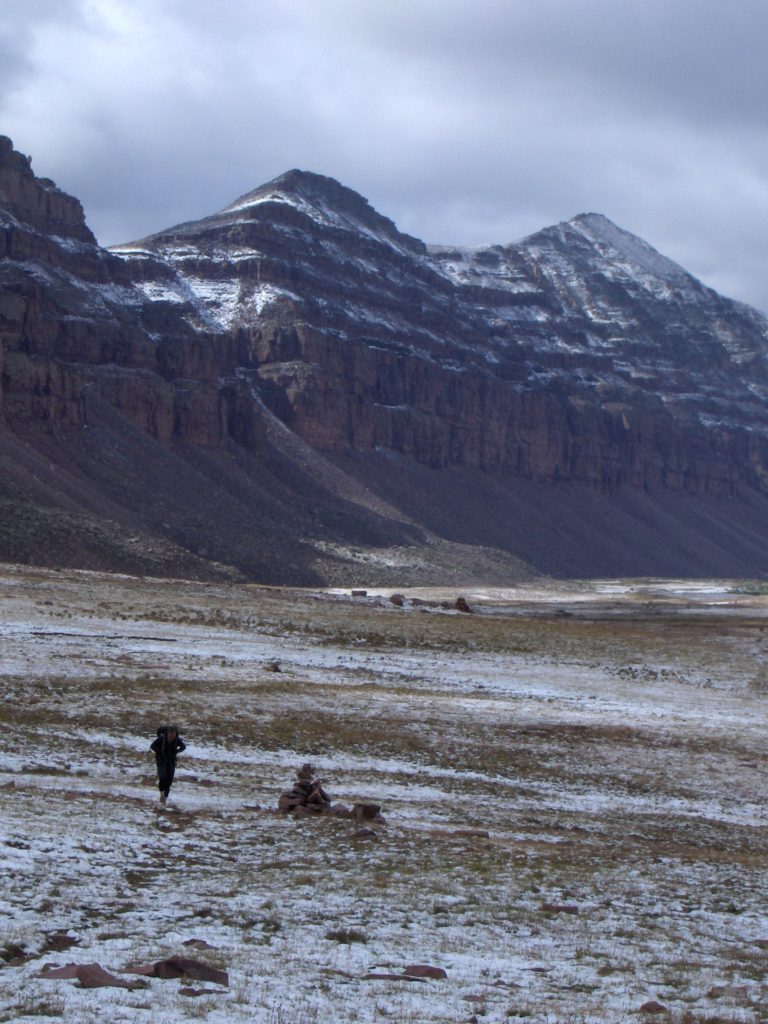
At Tungsten Pass we stopped and rested for the first time that day. We had already covered over ten miles in poor conditions and the spark of hope was rekindled. Once again I struggled to eat anything more than a Clif Bar. The beef jerky I had so lovingly created a week earlier brought only feelings of nausea. We dropped directly off Tungsten Pass downclimbing some short cliff bands to avoid a long trail jog. The weather appeared to improve to the south, but in every other direction the clouds were again building. Emmons and Kings Peak were both shrouded in heavy clouds and Anderson Pass was entirely hidden. Porcupine Pass behind us was again enclosed in a blanket of gray. The Tungsten sun had been a fleeting prize.
The muddy rolling hills of Yellowstone Basin passed slowly. Thunder boomed in the direction of Anderson Pass we again felt ominously like hobbits approaching the gates of Mordor on a quest gone wrong. Maybe it would lift by the time we reached the foundation of monolith. We herded random sheep as we moved, starting them from their grazing posts. Surely we were two of only a handful of humanoids seen this summer by these creatures. Mutton was the conversation. We slowly moved up the lightly tree’d hillside and then up to the barren slopes below the pass. Large boulders were strewn across the area like jacks in a game of marbles. Out of the mental safety of the trees the anxiety of being hit by lightning accentuated suddenly. The lighting was now more frequent and thunder tore through our ears. The ever present drizzle upgraded itself to full rain and snow appeared to be falling just above us on the mountainside. Kings Peak just to the east was being beaten by whips of lightning. We huddled next to one of these boulders feeling like mice trapped below an ogre. If we continued on we faced serious risk of being struck by lightning. If we waited we risked having to spend another night of hypothermia or worse. We opted instead for some divine guidance, apologizing for putting ourselves once again in a bad situation.
With the entreaty spoken, we looked at each other. “What do you think?” Hunter asks through the pelting rain. I had a strange ease that to me signaled us to move on. I responded as such and asked him what he felt. Nothing definitive was his response. We both started to move, the decision was made. There was a chance we might get struck by lightning on the crossing, but then there was a certainty that we would be hurting or possibly die by delaying our progress and spending another night. The switchbacks were arduous and the echoing thunder resounded around us. Yet the electricity seemed to be far above us. As we moved up the mountainside the clouds seemed to rise with us. Although our surrounding peaks were still socked in, we could see south and west across the vast expanse that we had just crossed in the last couple of hours.
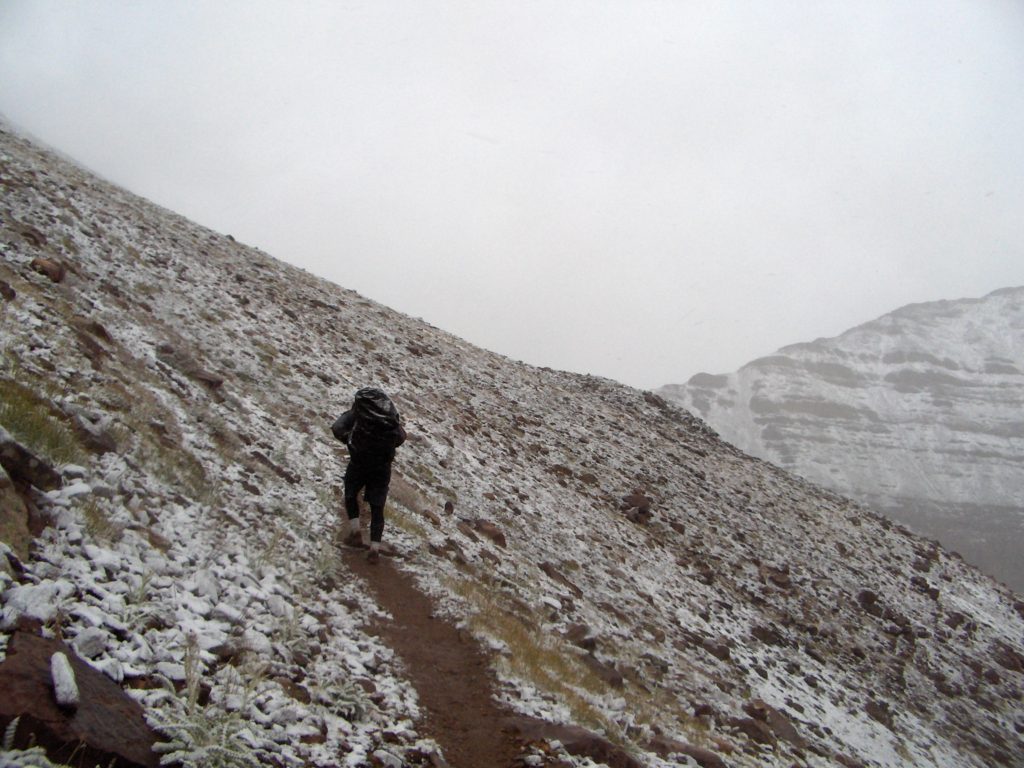
The snow was getting deeper (at least it seemed). Again, the only area clear of snow was the small stream running down the middle of the trail. The snow and hail was hitting us sideways like standing in front of a snow making machine. The lightning had seemed to lift as well and our optimism grew. Maybe we’d see another group waiting out the storm on Anderson Pass. Fat chance; we rounded the last switchback, crested the pass, and entered onto the King’s Peak super highway. Henry’s Fork to the north almost looked dry: another potential emergency exit. We could take the chute and be at Dollar Lake in an hour surrounded by babbling scouts. Or we could finish off the last 20 miles. At this point, the answer was obvious and the question didn’t even get entertained.
The miles leading down into Painter Basin were a relief but at the same time filled with trepidation. The clouds were soon far above us as we dropped down into the vast basin but the snow was still over our ankles and the trail that we were following was dubious at best. The entire area was a mix of gray and white, with the peaks around us stretching into the clouds. The familiar Gunsight Pass finally came into view and I kept expecting to see a cluster of Boy Scouts or Wasatch Mountain Clubbers hiking towards the now destitute summit of King’s Peak. Miles in the distance we could see the dark hollow of North Pole Pass- the literal last pass on the route. In the dark gray of the late afternoon it looked like the end of the world away. I figured it was at least 10 miles away, maybe 15 miles by trail. Three hours I mistakenly thought. We reached the Painter Basin trail junction and decided in the interest of time to take the more direct route along the Uintah River, even though it meant eventually more climbing than the circumspect upper route.
Luckily the route along the river was mostly straightforward and dropped elevation quickly taking us out of the snow. We made good time following the occasionally vague trail for the next six miles. We passed a huge herd of elk hiding on the outskirts of a massive meadow. We finally passed the first trail junction which I mistook as the second. Three miles further we were dragging. We hadn’t stopped in nearly 20 miles and were didn’t realize we were running on empty. At what seemed like an eternity we reached the final trail junction for Fox Lake. Even with the impending darkness we both decided to sit and rest. We both choked down some food and I offer Hunter some Ibuprophen, which he hesitantly took. It was the first drugs he had taken in years.
The food and drugs did wonders and within a mile we were each feeling far superior to our previous lagging. The elevation we had so enjoyed loosing now required gaining and in three miles we were back to our previous elevation. North Pole Pass gleamed with a gap in the clouds and we knew we were getting close. If we could just make it to the pass before it was pitch black, we would be fine. Another two miles brought us to a Forest Service trail detour which we promptly ignored. One more mile was Fox Lake and the ruined cabins of a past era. On the far side of the lake, we saw only the second people of our whole trip hidden off in the trees enjoying the early evening. I wonder what they thought as we trooped by with our small packs into the early night.
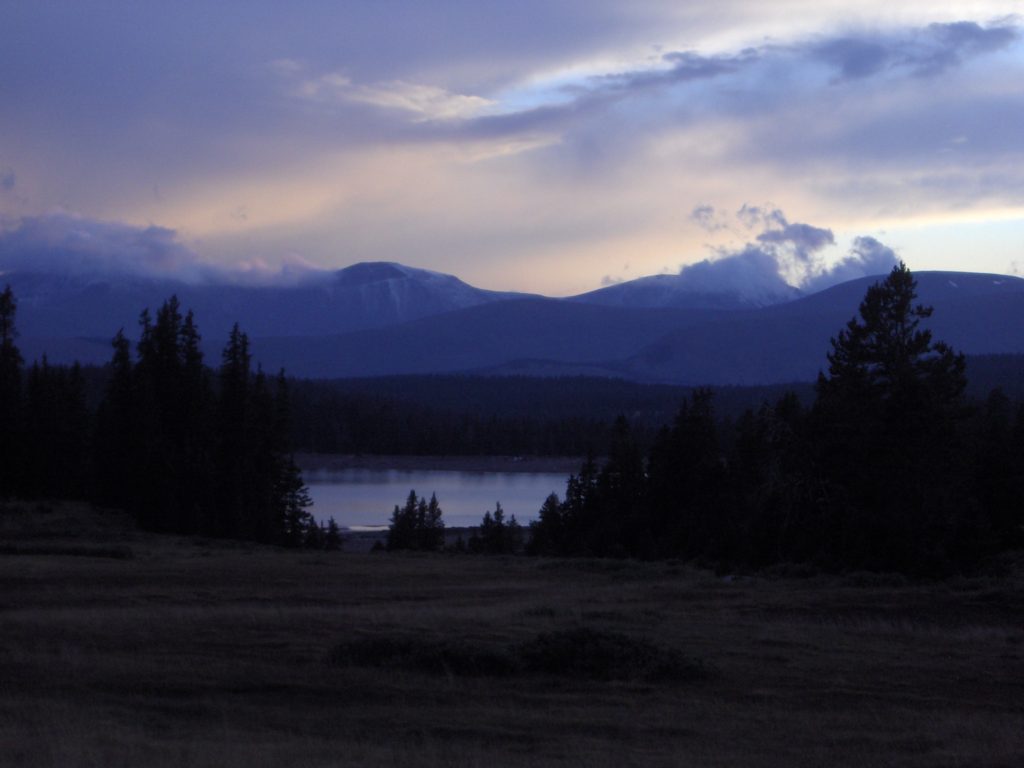
The base of North Pole Pass was finally reached in the last moments of visibility. I had remembered this pass as being the easiest of the passing, but now found it abrupt, barren, and name appropriately, cold. The starlight provided enough light for us to see the trail without needing headlamps and I struggled to keep up with Hunter’s climbing power. We were both fighting a personal battle trying to keep up with whoever was in front. Unable to see the distance above, the trail dragged on forever. But soon we were on the upper tundra of the North Pole making our way across the mile wide pass. Once again the trail was marked by massive stacks of rocks the stood out eerily against our newly donned headlamps. They were spaced just far enough apart to make us think we had lost the trail only to pick out a shape in the distance. Far in the bottoms below, I could see the headlamps of a car; presumably near the end of our trail. I felt a hint of relief.
We pass the vertical pine pole that apparently marked the North Pole and started our hopefully short descent to Chepeta Lake. We spread out as we travel down the snowy, wide, east side of the pass, each of us watching for the cairns that fed us downward. The trail was entirely inobvious due to the snow, lack of traffic, and darkness, but somehow we are draw northward and find ourselves switchbacking down into the black depths of our final miles. The trail leveled and we decided to stop and rest next to an old creepy sign pointing to lands unknown. Our last rest was nearly ten miles past and now in the dark, our race against the light was already lost.
I remembered my last descent into Chepeta Lake, ten years earlier, as being somewhat confusing but this time I underestimated the dark and our physical exhaustion. We started downward on those last four miles, finally leaving the snow, but once again entering the mud. The sky was moonless, the stars covered by clouds and then we entered into thickets of trees; it was the wild dark you rarely discover. Our weak LED headlamps did a poor job of dividing the obscurity and we stumbled from cairn to cairn, poor trail to poor trail. I watched the GPS incessantly, watching the tenths of a mile tick by. 2.1 miles left, 2.0, 1.9. Finally we were a half mile from the glorious finish I had dreamed about for months and prayed for what seemed like days. We moved out of the trees, pushed ourselves through a thicket of brush and suddenly we were standing on the shore of a partially drained lake. We had done it! It was just past 11 pm and over 65 miles and nearly 24 hours total travel hours of difficult, anxious, if not borderline perilous, hiking behind us. We had crossed the greater Uintah Range in two days, matching seven towering passes, sleeping in hypothermic conditions, and surviving heinous electrical storms and near blizzard conditions.
Hunter’s truck was just beyond the knoll and we could finally rest from our near trauma. Just beyond which knoll? Somehow in the next 15 minutes we became disorientated. With the inability to see more than thirty feet in front of ourselves, with no stars in the sky, and in our exhausted state we found ourselves walking in every which direction sure that this way was the correct way. A trail would be found, then lost, then another found. We would pass the same log again and again, follow a river downstream, then back upstream. Frustrations ran high. I almost smashed the GPS in irritation; how could it be so wrong?
It wasn’t. Near 2 AM we stood at a spot we had passed several times. One of us noticed an odd shape to the right; it was a berm of earth too linear to be natural. We shuffled over and found ourselves on the western edge of Chepeta Lake’s dam. Damn. We been within 100 yards of the road countless times, but our bubble of light never reached the necessary distance. We walked the quarter mile length of the dam and found ourselves walking the dirt road towards the trailhead parking. For nearly three hours we had bumbled in frustration.
We both crashed in the front bucket seats of Hunter’s truck and soon passed out. We were only awake long enough to start the car and blast the heater on every hour or so. My dreams are surreal. Am I hiking or have I lost the game? I wake early, far from lost, happy to be so worn down, so far from home, our goal so complete. We start the car and head for home down the beaten, wet, washboard dirt road. The dishes were done.
